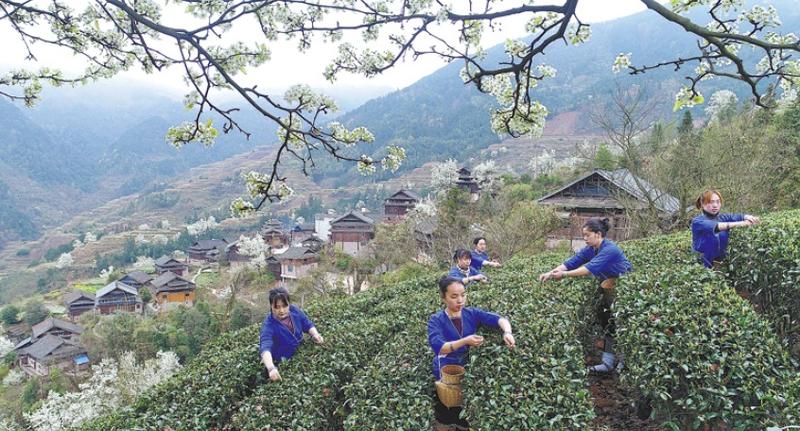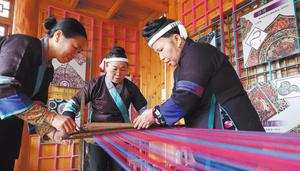 Farmers pick tea leaves in Guiling village of Bajiang, Sanjiang Dong autonomous region, Guangxi Zhuang autonomous county. (GONG PUKANG / FOR CHINA DAILY)
Farmers pick tea leaves in Guiling village of Bajiang, Sanjiang Dong autonomous region, Guangxi Zhuang autonomous county. (GONG PUKANG / FOR CHINA DAILY)
A road built with government support connecting Qucun village in Sanjiang Dong autonomous county of the Guangxi Zhuang autonomous region with the nearest town has brought this hitherto hidden treasure to the world and the world to its doors.
The road has essentially shortened commute time from more than 5 hours to just 50 minutes. Now not only do tourists, capital and knowledge flow in, but also agricultural produce and surplus laborers flow out of the village through it.
Many tourists call this place-home to the Red Yao people, a branch of the Yao ethnic group, for thousands of years-a kind of Shangri-La. Perched in the middle of the Baiyun Mountain ridge at an altitude of more than 1,200 meters, the village boasts of an emerald-like crystal-clear lake spread across 1 square kilometer, four waterfalls and a 60-meter-deep karst sinkhole.
Being remote, nestled as it is in the mountains, the hamlet has managed to preserve its traditional embroidery; shengxiao, or playing of a kind of reed-pipe wind instrument; and its women's style of curling up their long hair into a typical bun.
When Red Yao girls turn 13, they start learning how to weave from their mother or grandmother. They conceive designs directly on the cloth without any pre-drawn pattern. For generations, Red Yao women have been wearing clothes they have themselves wove.
They keep their hair long, letting it grow since childhood; curling it up into a bun later in life and wrapping it up in a black embroidered hood when they grow older. They apply special hair care supplements and have a special hairdressing custom for festivals.
Thanks to a shampoo made from herbs and rice water, their women's hair never turns white even when they age.
Most of these traditions have now become tourist attractions. The opening of the road has also exposed locals to the outside world, as some of the elderly villagers had ever stepped out of village until recently.
 Women from Yao ethnic group weave a brocade in Tongle, Sanjiang. (GONG PUKANG / FOR CHINA DAILY)
Women from Yao ethnic group weave a brocade in Tongle, Sanjiang. (GONG PUKANG / FOR CHINA DAILY)
Now, 93 percent of laborers from the village work as chefs, electricians, drivers and construction workers in the cities, thanks to vocational trainings organized by the county government.
The fast development of tourism and popularity of local agricultural products in recent years have helped lift many Qucun residents out of poverty.
Around 160 of the 251 village families once lived in dilapidated houses. Their houses have been rebuilt or they have been rehabilitated, says Deng Yibin, a 35-year-old civil servant in Nanning, capital of Guangxi, who has been working as secretary of the villagers' committee for three years.
"Once the villagers see their yield becoming popular in the market, more will follow suit," Deng says, explaining how he has encouraged farmers to plant organic edible fungus, potatoes, tea and rice.
Wan Xunmao, 31, is one of the early residents to have branched out from picking herbs and lumbering to raising pigs and growing cash crops. "Years ago I used to ask my husband if we can ever move from our shack to a 'concrete house'," she says. "I now live in a three-storey house."
Qucun village epitomizes Sanjiang county, home to multiple ethnic groups, where the well-preserved natural environment and ethnic culture have brought tangible benefits to local residents.
Sanjiang has the largest architectural complex of the Dong ethnic group in China, consisting of 108 shelter bridges and 159 drum towers, as well as large amounts of Dong residential building clusters.
Paying special attention to protecting the environment and ethnic culture, locals are taking advantage of livestreaming and e-commerce to make their hometown better known around the world. They also take care to preserve their heritage, believing that preservation is development, and the more original it is, the more modern it is.
Wu Yijun and Li Ziyu in Sanjiang contributed to this story.


